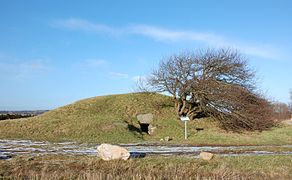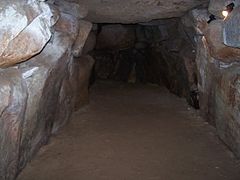Birkehøj
The passage grave Birkehøj on Odden- and Troldhøjvej near Nyrup in Odsherred on the Danish island of Zealand , looted in 1909, is next to the double passage grave Drysagerdys (13.2 + 11.8 m) and the Listrup facilities (at least 13 m) Falster , Græse (12.5 m) on Zealand and Kong Svends Høj (12.3 m) on Lolland as well as Jordehøj , Kong Asger Høj on Møn and Mårhøj on Fyn (10 m each) one of the largest megalithic complexes in the country. Passage graves were created between 3500 and 2800 BC. BC as megalithic systems of the funnel beaker culture (TBK). The passage grave is a form of Neolithic megalithic systems, which consists of a chamber and a structurally separated, lateral passage . This form is primarily found in Denmark, Germany and Scandinavia, as well as occasionally in France and the Netherlands.
- Birkehøj
description
The chamber is not the longest, tallest or widest, but probably the one with the largest enclosed space. The passage grave was extensively restored in the years 2002-2003. Birkehøj is a round hill about 30.0 m in diameter and 2.0 m high. The chamber is more than 11 meters long, 2.0 meters wide and high. Between the 24 inwardly inclined supporting stones and the eight ceiling stones, layers of large and small stones are inserted as so-called overhangs, which increase the chamber height. The corridor is about 1.2 m high and 70 cm wide. It has eight pairs of curb stones and six cap stones. The intermediate masonry between the supporting stones in the chamber and corridor consists of flat stone slabs.
A large number of archaeological finds are known from the passage grave. Axes , blades, chisels and arrowheads made of flint , amber beads , five broken clay pots and a small bronze ring show that the passage grave was used for about 1500 years, up to the Bronze Age .
See also
literature
- Ingrid Falktoft Anderson: Vejviser til Danmarks oldtid . 1994, ISBN 87-89531-10-8 , p. 236
Web links
Coordinates: 55 ° 55 '58.4 " N , 11 ° 35' 58.8" E



